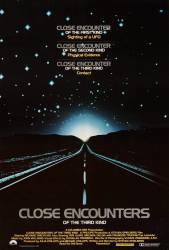Revealing mistake: In the scene where Ronnie cuts out a newspaper article about the UFO sightings, the night after Roy's first glimpse of the UFOs, two identical articles on Star Wars (1977) are on either side of the UFO article.
Suggested correction: The articles aren't identical, they are continuous. I read them. Only the title, "wars" is identical.
Character mistake: When Ronnie is cutting the article about Roy's encounter out of the newspaper, the title of the article begins with "UFO's...", the apostrophe making it possessive. It correctly should have been "UFOs...", with no apostrophe making it plural as intended.
Suggested correction: You are incorrect. The article is actually correct. It is used as a contraction, not a possessive. http://www.thepunctuationguide.com/apostrophe.html.
It's not a contraction. A plural acronym is simply "s" added to the acronym. An apostrophe never indicates plurality.
Suggested correction: There is no standard on how to pluralize initialisms or acronyms and either way is acceptable, depending on a person's preference. An apostrophe does not automatically make something possessive, such as using apostrophes in contractions to replace missing letters.
Nope. In contractions joining two words, apostrophes only replace vowels (typically the letter "o," such as in "hasn't" or "wouldn't" or "isn't," and most obviously with "it's" replacing the letter "i" in "it is"). In this case, the acronym "UFOs" stands for "Unidentified Flying Objects," and there is no vowel to replace between the "t" and the "s" (in fact, an apostrophe wouldn't replace any letter at all). So, the contraction argument is invalid. Using an apostrophe for "UFO's" makes the acronym singular possessive (such as in "The UFO's movements were erratic").
It seems you missed the point of my comment. What you're stating is an opinion on how to pluralize initialisms and acronyms. While many lean towards just adding an "s", many real life publications back in the 70's did in fact use and "apostrophe s" for initialisms and acronyms. (Notice how 70's isn't possessive or a contraction. But many prefer using "70s.").
"Many publications" were wrong (especially in the late 1970s) and followed poor literary and journalistic standards. No, it's not a "matter of opinion"; throwing in apostrophes where they are not appropriate is a matter of poor education in the English language.
The question is not whether using the apostrophe is "correct" or "appropriate." It's whether it was used by publications in the '70s. It was, therefore it is not a mistake.
You should be more educated when stating opinions then, because it wasn't about being wrong. It was about no set standard. For example "The Chicago Manual of Style" would recommend UFOs while "The New York Times Manual of Style and Usage" would recommend UFO's. Of course, both would recommend using the apostrophe when making single letters plural "A's" or p's and q's."
The New York Times manual of style is predictably bogus. I'm a professor of Journalism (Southwest Texas State University 1979 to 1987). I know what is proper.
Continuity mistake: When Roy first encounters the alien ship at the railroad crossing, when the bright light comes on, he leans out of the truck window, and the right side of his face is exposed to the light. Therefore, it is the right side of his face that should have been burned. Subsequent shots show that the left side of his face is burned. (00:21:00)
Suggested correction: Roy shields the right side of his face with the hand holding the torch so that it's not exposed. His left side is not covered so it gets burnt.
How could the left side of his face get burned, if it's not exposed to the light?.





